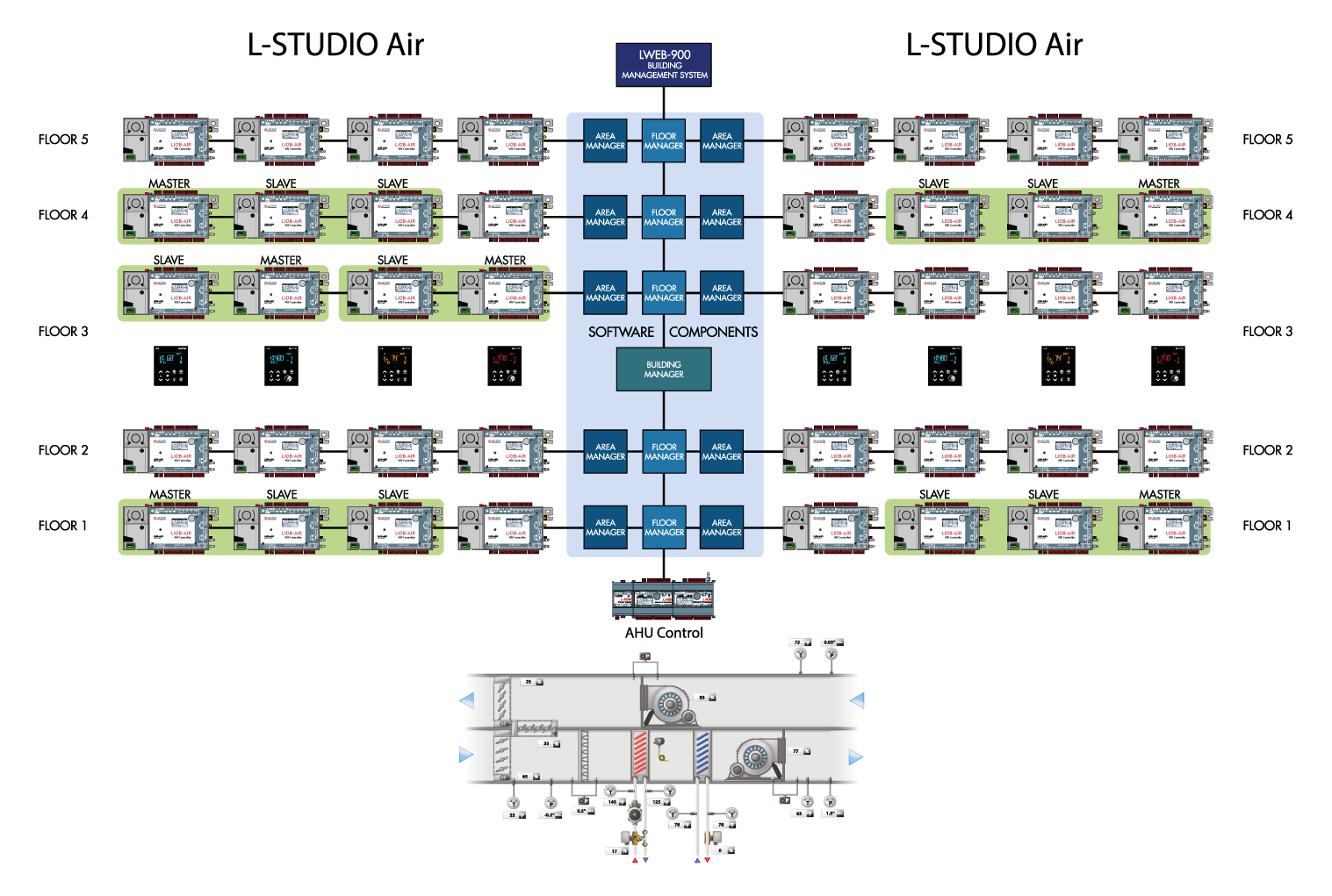
Task:
The VAV system for a new energy-efficient office building shall provide heating, ventilation, and air conditioning (HVAC). The following functions are required for each office room:
- Demand-controlled ventilation based on CO2 sensors and occupancy,
- Room temperature control with user-adjustable offset,
- User temperature and occupancy control by wall-mounted panels,
- Web-based control for mobile phones.
The VAV system shall interface with an existing air handling unit (AHU) to
- communicate air demand to the AHU and
- receive outdoor air temperature and quality from the AHU for control optimization.
The VAV system shall be configurable by an operating workstation for maintenance and mobile devices shall be used for setting up and balancing the ventilation system.
Solution:
The solution consists of the following products:
- LIOB-AIR1 devices for ventilation control,
- LWEB-900 as operating workstation,
- L-STAT room panels for standard office rooms,
- L-VIS room panels for conference and community rooms.
LIOB-AIR1 devices are mounted all each ventilated rooms. Each LIOB-AIR1 measures air flow with its differential pressure sensor and controls a damper with its direct-attached drive. With its additional physical inputs, discharge temperature for room comfort are measured and window contacts for the energy hold off function are monitored. Its TRIAC outputs control the valves of the hot water peripheral heat and the hot water reheater. Relay outputs are used to control the serial fan of the VAV box.
The physical I/Os of the LIOB-AIR1 are complemented by the remote sensor equipment of the L-STAT room control panel. The L-STAT measures air temperature, relative humidity, and CO2 concentration of the controlled room. The user can select his or her convenience temperature and fan settings. Occupancy is determined by its internal occupancy sensor, but of course, occupancy also can be signaled manually.
Conference rooms as well as public and community areas are equipped with LVIS-3ME7 touch panels. Their frameless glass fronts seamlessly integrate into any interior design. Graphical projects have been designed to reflect the corporate identity of the building owner.
The entire VAV system and visualization has been created in the L-STUDIO application which allows to design the logic application and visualization side-by-side. The VAV library provided templates for creating the VAV types needed for the project. The communication between the VAV boxes and the AHU are automatically created within L-STUDIO and do not need any external binding tools. The graphical symbols of the VAV library enabled the integrator to quickly design the visualization projects requested by the client.
LWEB-900 has been deployed as the main operating workstation. It supports all tasks, starting from project creation through parameterization up to maintenance.
The LIOB-AIR System Hierarchy:

The LIOB-AIR system consists of a building with numerous floors. Floors in turn consist of one or several areas. For large properties, it is also possible to configure a campus with several buildings. Areas, floors, buildings are managed by managers. A manager is a software component that can be executed on any LIOB-AIR VAV controller. The area manager aggregates data like CO2 content in the area, required air flow into the area, required fresh air content in the area, etc. from all LIOB-AIR VAV controllers in its area and reports the aggregated values to the floor manager. The floor manager aggregates all results from the area managers on the floor and reports the aggregated values to the building manager. The building manager communicates with the air handling unit (AHU) and provides all necessary data to the AHU for an energy optimized operation of the ventilation system. Each manager can deal with up to 8 air supply zones and provides the aggregated values for each air supply zone separately. All communication relationships between the LIOB-AIR VAV controllers are generated automatically and adapt themselves to changing system layouts.
Benefits:
The LIOB-AIR application provides all control functions for any combination of sensors and actuators and can be easily adapted to the sensor equipment of the project. The integrator can select between available actuator types, such as floating or modulating dampers or different reheater actuators.
The parameterization of the VAV system can be done by the balancer on a mobile device or on the LWEB-900 operating workstation. The built-in LWEB-802 application allows different access levels for the balancer and the system administrator. Balancing tasks such as calibrating and tuning the damper system can also be done directly in the LWEB-802 application.
The VAV controllers in the LIOB-AIR system communicate and exchange information on air supply and demand with the air handling unit. The system can automatically summarize air demands of a supply zone and communicate changes in air demand to the air handling unit. An air handling unit can also demand forced air flow so that the VAV controllers take off a minimum amount of air.
Every VAV controller provides alarming, scheduling, and trending features which can be used stand-alone or together with LWEB-900.
Features:
The LIOB-AIR1 model provides the following features:
- Variable Air Volume control
- Demand-controlled ventilation based on different sensor types (CO2, VOC, people count)
- Temperature control
- Discharge temperature control
- Manual, sensor, and scheduled occupancy
- Support for serial and parallel fans
- Support for electric and hot water reheaters
- Support for electric and hot water peripheral heats
- L-STAT support
- Built-in LWEB-802 configuration application for mobile access
- Automatic communication between AHU and VAV controllers
- Grouping of supply and exhaust boxes in complex ventilation scenarios
- Central override functions for balancing and service operations
- Seamless integration with L-ROC system for sunblind and heating control
- Integration into BACnet and CEA-709 networks
Range of application:
The LIOB-AIR solution can be used from simple stand-alone VAV installations up to large office buildings with multiple air handling units and building control systems. It supports all types of physical inputs and communication protocols that allows interfacing to all common building infrastructures.

